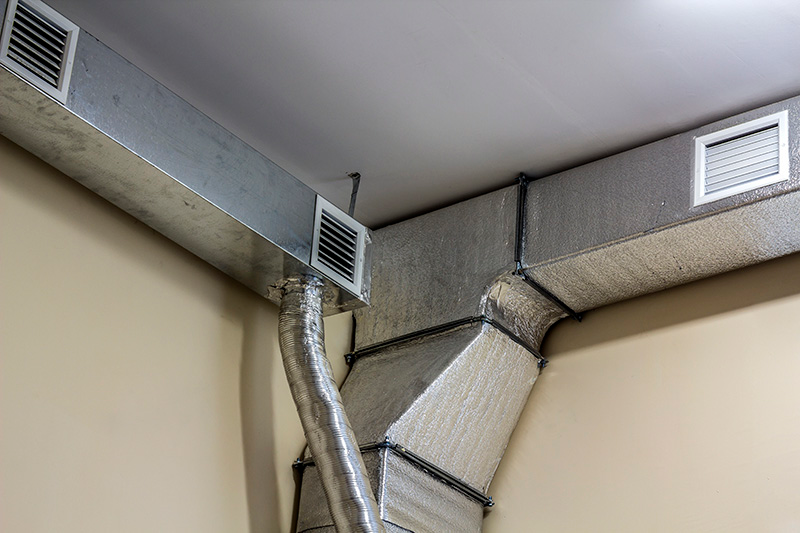What is Duct Work?
What Is Ductwork?
Ductwork is a system of connected tubes or channels used in heating, ventilation, and air conditioning (HVAC) systems to distribute and circulate air throughout a building. It delivers conditioned air (heated or cooled) to various rooms and returns stale air back to the HVAC unit for reconditioning. Typically made from sheet metal, fiberglass, or flexible plastic, ductwork plays a vital role in maintaining indoor comfort, air quality, and energy efficiency.
Why Ductwork Matters
Your duct system doesn’t just carry air—it determines how efficiently and evenly your HVAC system performs.
Comfort: Consistent temperatures in every room.
Efficiency: Lower energy bills with less strain on your HVAC equipment.
Air Quality: Cleaner indoor air when ducts are sealed and free from dust or mold.
Noise Control: Reduced operational noise with well-insulated ducts.
Types of Ductwork
Rigid Ductwork
Made of sheet metal (typically galvanized steel or aluminum).
Durable, long-lasting, and easy to clean.
Ideal for main supply and return ducts.Flexible Ductwork
Made from a plastic inner core wrapped in insulation and covered with a protective layer.
Easier to install in tight or awkward spaces.
Best for short runs or connecting to rigid ducts.Fiberglass-Lined Ducts
Insulated from the inside to reduce noise and thermal loss.
Common in commercial buildings or areas with high noise concerns.

Why Ductwork Matters
Your duct system doesn’t just carry air—it determines how efficiently and evenly your HVAC system performs.
- Comfort: Consistent temperatures in every room.
Efficiency: Lower energy bills with less strain on your HVAC equipment.
Air Quality: Cleaner indoor air when ducts are sealed and free from dust or mold.
Noise Control: Reduced operational noise with well-insulated ducts.
How Ductwork Works
Here’s a simplified overview of how air flows through a duct system:
Air Intake: The system pulls indoor air through return vents.
Air Conditioning: That air goes to your HVAC unit where it’s heated or cooled.
Air Distribution: Conditioned air moves through supply ducts and into your rooms via vents/registers.
Air Recirculation: The process repeats, maintaining a consistent indoor temperature.
This system relies on proper airflow, pressure balance, and insulation for maximum efficiency and comfort.

Signs Your Ductwork Needs Attention
Over time, ductwork can degrade or develop issues that affect your comfort and utility bills. Watch for:
- Uneven room temperatures
Excess dust in your home
Whistling or rattling noises
Higher energy bills
Moldy or musty smells

Ductwork Problems to Avoid
Leaks & Gaps: Up to 30% of air can be lost due to poorly sealed ducts.
Poor Insulation: Leads to energy waste, especially in unconditioned spaces like attics.
Improper Sizing: Undersized or oversized ducts affect airflow and system performance.
Dirty Ducts: Can circulate allergens, mold spores, and dust.
Ductwork Installation Process
Evaluate HVAC System & Layout
We assess your home’s size, room layout, and HVAC unit capacity to determine the optimal duct design and airflow needs.Shut Down System Power
For safety, we turn off power to your HVAC system before starting any installation work.Mark & Cut Duct Openings
We mark the locations for supply and return vents, then cut precise openings in walls, ceilings, or floors as needed.Install Main Trunk & Branch Lines
Rigid or flexible ducts are installed from the air handler to each room. We secure them using hangers, brackets, or straps for support.Add Return Air Ducts
Return ducts are installed to draw air back to the system, ensuring proper circulation and pressure balance.Seal All Duct Joints
We seal every connection using mastic or foil-backed tape to prevent air leaks and improve energy efficiency.Insulate Ductwork (if needed)
Ducts in attics, basements, or other unconditioned spaces are wrapped in insulation to maintain air temperature and prevent condensation.Install Vents & Registers
Supply and return registers are mounted to the duct openings, ensuring clean and balanced air distribution throughout your home.Test System & Adjust Airflow
After installation, we test the HVAC system, check airflow at each vent, and make adjustments to ensure comfort and performance.
How We Troubleshoot and Fix Ductwork Issues
Consult a Professional
Even if you’re knowledgeable, a certified HVAC technician can:
Perform load and airflow calculations
Recommend duct types based on your specific layout
Ensure code compliance and proper installation
Duct Repair and Airflow Correction Process
Power Down the HVAC System
We begin by safely shutting off power to avoid electrical hazards during inspection and repairs.Conduct a Thorough Inspection
We examine all accessible ducts for visible damage, disconnections, crushed sections, and signs of leaks or wear.Check for Airflow Imbalances
Using tools like anemometers or pressure gauges, we measure airflow at vents to detect underperforming areas.Seal Air Leaks
We seal all identified leaks with professional-grade mastic or foil-backed HVAC tape to restore efficiency and reduce air loss.Repair or Replace Damaged Sections
Any duct sections that are torn, rusted, or collapsed are either repaired or replaced with compatible materials.Secure and Support Duct Runs
We re-strap or re-hang loose ductwork to eliminate sagging, rattling, or airflow blockages.Test the System After Repair
Once repairs are complete, we restore power and test airflow again to confirm that the system is balanced and efficient.Document the Issues & Recommend Prevention
We provide a summary of what was fixed and offer maintenance tips or upgrades to help prevent future problems.
Duct Maintenance for Long-Term HVAC Efficiency
Inspect the Entire Ductwork
We check for visible damage, dust buildup, loose connections, and signs of wear.Clean Ducts if Needed
We recommend professional cleaning to remove dust, debris, and allergens (usually every 3–5 years).Seal Any Leaks
We ensure all joints and seams are sealed properly to prevent air loss and improve efficiency.Check Insulation
We inspect insulation around ducts in unconditioned spaces and replace any that’s missing or damaged.Secure Loose Ducts
We fasten or re-hang any sections that are sagging, noisy, or poorly supported.Adjust Dampers for Airflow Balance
We test airflow and make adjustments to keep temperatures even in every room.Test System Efficiency
We evaluate airflow, pressure, and overall performance to ensure your HVAC runs smoothly.
FAQs
What is ductwork and why is it important in an HVAC system?
Ductwork refers to the system of metal or flexible tubes that distribute heated or cooled air throughout a building. Properly designed ductwork ensures efficient airflow, balanced temperatures, and better indoor air quality.
How can I tell if my ductwork needs repair or replacement?
Signs include uneven temperatures in different rooms, high energy bills, excessive dust, strange noises, or visible damage like rust or disconnected joints. An HVAC inspection can confirm any issues.
How often should ductwork be cleaned?
It’s generally recommended every 3–5 years. However, more frequent cleaning may be needed if you have pets, allergies, recent renovations, or signs of mold and dust buildup.
Is duct insulation necessary?
Absolutely. Insulating ducts—especially those running through unconditioned spaces like attics or basements—helps maintain air temperature and boosts energy efficiency.
Testimonials
Honest Reviews from our Customers

Jane Anderson
Homeowner, San Diego

